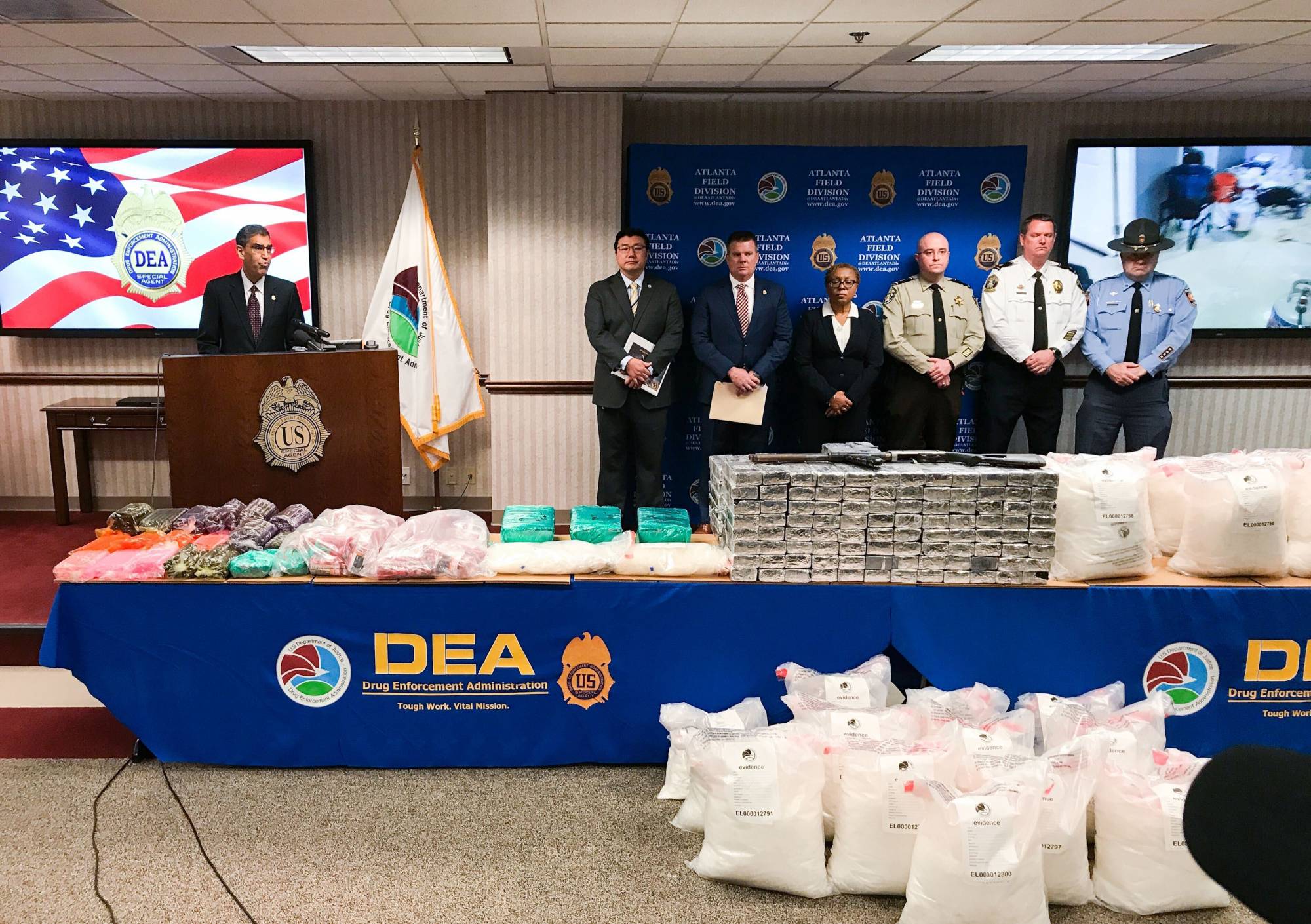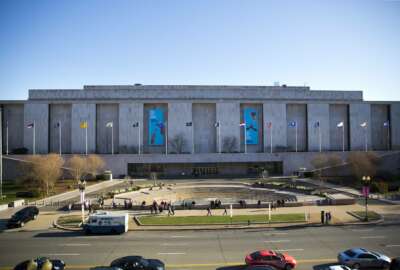
The DEA reopens its museum after a two year renovation
In a city filled with museums, large and small, this one is a standout. After a two-year hiatus for renovation, the Drug Enforcement Administration museum has...
Best listening experience is on Chrome, Firefox or Safari. Subscribe to Federal Drive’s daily audio interviews on Apple Podcasts or PodcastOne.
In a city filled with museums large and small, this one is a standout. After a two-year hiatus for renovation, the Drug Enforcement Administration museum has re-opened its doors to the public. Yep, the DEA Museum. Federal Drive with Tom Temin got some of the highlights from museum director Jan McKay.
Interview transcript:
Tom Temin: Ms. McKay, good to have you on.
Jan McKay: Well, thank you, Tom. It’s nice to be here.
Tom Temin: And I guess you were kind of lucky to close for renovation in the same two years that the pandemic probably would have kept everybody away, anyhow.
Jan McKay: Yeah, you know, it really gave us an opportunity to craft a beautiful new museum for the community and for America, actually. And so we took the opportunity to really update the museum to use all the best practices and museum design and interactivity. And we came up with something that’s just quite amazing, and really a showstopper.
Tom Temin: And what is the purpose of this museum? Because you don’t think of drug enforcement as something necessarily a highly visual activity except for the arrests and the klieg lights and that kind of thing.
Jan McKay: Yeah, you know what, I hear you because a lot of people misunderstand what DEA is about. So the museum is very comprehensive, and that it does explain the DEA’s history, and what we do as an agency and what the people of DEA do. So it’s not just about federal agents, per se, but also about all the other roles that people play here at DEA. So there’s a large component there. But then there’s also a large component that talks about the careers that people can, young people can think about. But moreover, there’s a lot about drugs, as you might expect, and the history of drugs, and the history of drug use and misuse in a whole area that’s interactive timelines on specific drugs, actually.
Tom Temin: And drugs have been a scourge for the United States for a long time, both in terms of public health, in terms of personal tragedies that drug use has produced, and in terms of federal efforts, so I guess when you add that up, you’ve really got a lot of ground to cover?
Jan McKay: You know, we really do. And we’re, the museum is part of the community outreach and prevention support services of DEA. And there are a lot of people working in that end of things. So we’re the flagship, kind of the physical manifestation of that. And we just love that the museum’s for all ages. And so when it was redesigned, it was created to make sure young people feel comfortable. And we have all the whiz-bang technology and all the things they can touch and do. Little ones can listen to a tip line. Parents who love artifacts, we have 180, on exhibit out of the DEA museum collection. And there’s something for everybody to see and do. And then really importantly, the museum has added an education space in the museum itself. So we can host school groups and other kinds of groups that want to come in and get a more immersive one-on-one experience with some of our employees,
Tom Temin: Perhaps with the opioid and the fentanyl epidemic, manifesting itself in a way that is really difficult for the nation, there must be a lot of interest in that type of presentation in the in this lecture and, and event space.
Jan McKay: Yes, actually, where we have a lot of curriculum on our museum website for schools and teachers. But we also do lectures and presentations every quarter. In fact, one is coming up in June that is especially interesting. It’s about how drug production across the globe and here in America affects the environment. And we’re really excited to bring that and pull that together. And it will be the third week of June. I don’t have the exact date yet, But it’s forthcoming. On top of that we have had many, many school groups, from college kids that are tourists visiting, to students from the area itself, and that what’s unique about the DEA Museum is when you make that reservation, we try and match you up with the right employee about the right topic that the teacher is actually interested in. And so we’re very proud of that. And we’re just getting started on that as well.
Tom Temin: We’re speaking with Jan Mackay, she is the director of the Drug Enforcement Administration museum. And yeah, just highlight that for us. Is it generally open to the public? Do you have to need a reservation to come in? Or how does that all work?
Jan McKay: Yes, we’re free. We’re open to the public Tuesday through Saturday from 10am in the morning till 4pm at night, if you’re bringing a group of 10 or more, we really ask that you make a reservation. Being in a federal building, there are some security protocols that that the visitor has to experience. But it’s very easy to get here. We’re right by the Pentagon metro station, and right across from the Pentagon City mall if you wanted to go shopping or do whatever. So we’re in a very convenient spot.
Tom Temin: And you mentioned at the beginning that it’s re-opening after a renovation. How far back does the museum go?
Jan McKay: Sure. Well, the museum actually opened in 1999 and it was very, very comprehensive, and full of so many great artifacts, examples of some of the great, great cases and drug takedowns that had happened over its years. So it’s been around for almost half the time that DEA has been around. And DEA is celebrating its 50th anniversary in 2023 right next year. So the interactive exhibits and the hands-on activities now cover a lot of the same things. But we can dive deeper now because of the technology that we’re using in the exhibit itself.
Tom Temin: And to do the new design and the new exhibits. Where did you get some help on what ‘state of the art’ is these days?
Jan McKay: Well, we had professionals in museum design and fabrication, and we had excellent people that, primarily from the DC area. Private companies working with us and it over a two-year period. And then as far as the content is concerned, as, as you can imagine, we have the content experts here to really know what to bring forward, especially when we talk about young people and drugs and parents and how they can start a conversation with their kids about drugs and the dangers of drug misuse.
Tom Temin: What about you? Are you a museum person, a drug enforcement person? What how do you get to this spot?
Jan McKay: Well, I appreciate you asking me that. I am not a DEA long-term employee. I’m a museum person if you want to put it that way. But I have the experience of using the DEA Museum’s traveling exhibit when I ran a science center. And I met so many wonderful DEA people. And I saw the impact of that traveling exhibit in that community and what it did for community conversation. And so we’re excited that that exhibit is going back on the road starting this fall. And it will be traveling to different cities across America. It’s already been to 19 cities since it was formed, and it’s called” drugs, costs and consequences.” So that’s a big part of what the Museum does also.
Tom Temin: And by the way, does the museum also highlight some of the DEA ‘s activities with respect to legal drugs? Because they have some regulatory and enforcement jobs there also?
Jan McKay: Yes, absolutely. There is a component of the exhibit is on what the DEA does, as an agency. There’s also information on how the DEA was formed and the predecessor agencies that formed the DEA. So there’s a lot of that as well. We also have some beautiful artifacts on exhibit that relate to things that happened around the world in the DEA’s history and different things that were picked up by our agents as they traveled.
Tom Temin: And what are some of the highly visual exhibits people might be expected to wander into when they come there?
Jan McKay: Sure. Well, I I’m not sure if I mentioned the El Chapo exhibit yet. So there is an a spotlight exhibit on that, that man and you can see his prison uniform. And some of the really flashy guns that he used. There is an exhibit on some of the materials that that our DEA agents use in the field. Everything from just everyday objects that that you can imagine we have a whole exhibit on pills, pill presses, bottles from the late 19th century to today, and everything in between.
Tom Temin: And I really liked the forfeited Hells Angels’ motorcycle.
Jan McKay: Yes. And so there is that Hells Angels’ motorcycle seized from a drug dealer in Massachusetts a while ago. It’s very flashy, it’ll be up for awhile. It’s in what we call our changing exhibit space. And that will change twice a year.
Tom Temin: Sounds like it’s open now and renovation is complete and people should just get over there.
Jan McKay: We are open for business and we welcome everybody and as I said Tuesday through Saturday from 10 to four. If you want to bring your school group or arrange a field trip maybe in this spring or this fall, please do contact us. Our curator of education is very excited to welcome young people to the museum.
Tom Temin: Jan McKay is director of the DEA museum, by the way, that’s in Arlington, Virginia at DEA headquarters. Thanks so much for joining me.
Jan McKay: Thank you Tom. Appreciate it. Please do come down and visit us.
Copyright © 2024 Federal News Network. All rights reserved. This website is not intended for users located within the European Economic Area.
Tom Temin is host of the Federal Drive and has been providing insight on federal technology and management issues for more than 30 years.
Follow @tteminWFED
Related Stories




